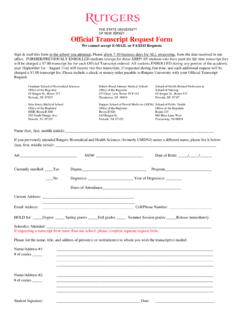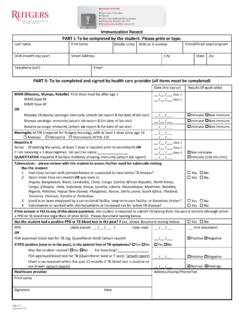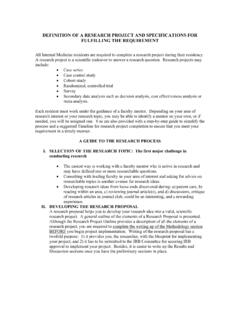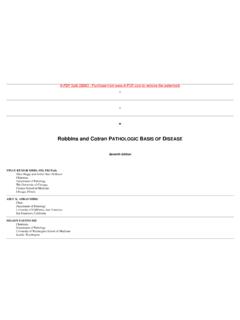Transcription of Hypersensitivity Reactions (Types I, II, III, IV)
1 Hypersensitivity Reactions (Types I, II, III, IV)April 15, 2009 Inflammatory response - local, eliminates antigenwithout extensively damaging the host s immune & inflammatory responses that are harmful to the host (von Pirquet, 1906)-Type IProduce effectormoleculesCapable ofingesting foreignParticlesAssociation withparasite infectionModified fromAbbas, Lichtman & Pillai, Table 19-1 Type I Hypersensitivity responseIgEVLCLVHC 1 Normal serum level = mg/mlBinds to mastcellBinds Fc region of IgEIntracellularsignal of degranulationLarche et al. Nat. Rev. Immunol 6:761-771, 2006 Abbas, Lichtman & Pillai,19-8 Factors in the development of allergic diseases Geographical distribution Environmental factors - climate, air pollution, socioeconomic status Genetic risk factors Hygiene hypothesis Older siblings, day care Exposure to certain foods, farm animals Exposure to antibiotics during infancy Cytokine milieuAdapted from Bach, JF.
2 N Engl J Med 347:911, 2002. Upham & Holt. Curr Opin Allergy Clin Immunol 5:167, 2005 Also: Papadopoulos and Kalobatsou. Curr Op Allergy Clin Immunol 7:91-95, 2007 IgE-mediated diseases in humans Systemic (anaphylactic shock) Asthma Classification by immunopathological phenotype can be used to determine management strategies Hay fever (allergic rhinitis) Allergic conjunctivitis Skin Reactions Food allergiesDiseases in Humans (I) Systemic anaphylaxis- potentially fatal - due to food ingestion(eggs, shellfish, peanuts, drug Reactions ) and insect stings- characterized by airway obstruction and a sudden fall in blood in Humans (II)Bronchial asthma Chronic inflammation Intermittent & reversible airway obstruction Chronic bronchial inflammation with eosinophil infiltration Bronchial smooth muscle hypertrophy and hyperreactivity Dominated by the presence of eosinophils, CD4+ T lymphocytes (Th2), and a largeproportion of CD4+ NKT cells expressing an invariant T cell receptor that recognizesglycolipid antigens.
3 National Heart Lung Blood InstituteKumar et al, Robbins and Cotran pathologic basis of DiseaseAnti-IL-13 -reduce mucus overproductionand eosinophiliaAnti-chemokinereceptors: CCR3, CCR4, CCR8 on or-eotaxin abs toprevent recruitment ofeosinophilsMediators and treatment of asthma19-10 Targeting SykDiseases in Humans (III) Upper respiratory tract Allergic rhinitis (hay fever) - Reactions to plant pollen or house dust mites in the upper respiratory tract - mucosal edema, mucus secretion, coughing, sneezing, difficult in breathing - also associated with allergic conjunctivitis. Some evidence that asthma can develop in patients who have allergic rhinitis. Treatment - antihistamines Gastrointestinal tract Result from release of mediators from intestinal mucosal and submucosal mast cells following sensitization through the route of exposure - enhanced peristalsis, increased fluid secretion from intestinal cells, vomiting, and diarrhea.
4 This is not the same as an anaphylactic response. Reactions usually begin in childhood - often remit in late childhood or in adulthod. Skin Urticaria (wheal and flare) - mediated by histamine. Eczema - late-phase reaction to allergen in the skin -inflammation - can be treated with Slice of Life & Suzanne S. Stensaas - obtained from PEIR, Dept. of Pathology, UABA topic EczemaCopyright Slice of Life & Suzanne S. Stensaas - obtained from PEIR, Dept. of Pathology, UABR adioallergosorbent Test (RAST)1st study of allergen-specific immunotherapy:Noon, L. Prophylactic inoculation against hay feverLancet I, 1572-1573 (1911)Desensitization/Allergen-Specific ImmunotherapySubcutaneous or sublingual administrationPeanut Flour May Ease Peanut Allergyfrom WebMD a health information Web site for patientsFebruary 24, 2009. Eating a tiny bit of peanut flourevery day may increase peanut tolerance in childrenwho are allergic to peanuts, a new study child went home with instructions to eat 5 mg of peanut flour mixed with yogurt each day, graduallyadding more peanut flour over the next six role of IgEAbbas & Lichtman 14-4 Type II Hypersensitivity Mediated by abs directed towards antigens present on cell surfaces or the extracellular matrix (type IIA) or abs with agonistic/antagonistic properties (type IIB).
5 Mechanisms of damage: Opsonization and complement- and Fc receptor-mediated phagocytosis Complement- and Fc receptor-mediated inflammation Antibody-mediated cellular dysfunctionKumar et al. Robbins and Cotran pathologic basis of DiseaseExamples: autoimmune hemolytic anemia, autoimmune thrombocytopenic purpuraKumar et al. Robbins and Cotran pathologic basis of DiseaseExamples: pemphigus vulgaris, Goodpasture syndromeKumar et al. Robbins and Cotran pathologic basis of disease . Elsevier et al. Robbins and CotranPathologic basis of disease . Elsevier2005 Kumar et al. Robbins and Cotran pathologic basis of disease . Elsevier et al. Robbins and Cotran pathologic basis of DiseaseExamples: Graves disease (hyperthyroidism), myastheniagravisNon-autoimmune type II Reactions Transfusion Reactions (ABO incompatibility Hemolytic disease of the newborn (erythroblastosis fetalis)Type III Hypersensitivity (immune complex disease )Mechanisms ofAb depositionEffector mechanismsof tissue injuryAbbas and Lichtman, Cellular and Molecular Immunology (5th edition).)
6 Elsevier 2003. Serum sickness - a transient immune complex-mediated syndromeArthus reactionPeaks @ 4-8 hoursVisible edemaSevere hemorrhageCan be followed byulcerationFormation of circulating immune complexes contributes to the pathogenesis of: Autoimmune diseases SLE (lupus nephritis), rheumatoid arthritis Drug Reactions Allergies to penicillin and sulfonamides Infectious diseases Poststreptococcal glomerulonephritis, meningitis, hepatitis, mononucleosis, malaria, trypanosomiasisKumar et al. Robbins and Cotran pathologic basis of disease . Elsevier et al. Robbins and Cotran pathologic basis of disease . Elsevier & Rolph, Germ Zappers, Cold Spring Harbor Laboratory Press, 2001 Balkwill & Rolph, Germ Zappers, Cold Spring Harbor Laboratory Press, 2001 Type IV Hypersensitivity (DTH)Kumar et al. Robbins and Cotran pathologic basis of disease . Elsevier 2005(Th1)IFN- , LT, IL-2, IL-3, GM-CSF, MIFIL-8, MCP-1 Autoimmune diseases mediatedby direct cellular damageTop - Goldsby et al, Figure 20-1- Hashimoto s thyroiditisBottom - Goldsby et al, Figure 20-3 - Type I diabetesClinical and patch test appearances of contact hypersensitivityRoitt Hypersensitivity reaction Roitt in the skinKumar et al.
7 Robbins and Cotran pathologic basis of disease . Elsevier of tuberculin-type reactionsDemonstration of past infection with a of cell-mediated immunity. APC/IL-12CD4+Th1 (IL-2)/IFN- MonocytesThe importance of TNF- in the formation ofgranulomasRoitt associated with granuloma formation: Leprosy Tuberculosis Schistosomiasis Sarcoidosis Crohn s diseaseSaunders and Britton. Immunol. Cell Biol. 85: 103-111, expressionin tissues fromM. tuberculosis-infectedindividualsSaunders & Britton. Immunol. Cell Bioll. 85:103-111, 2007 TuberculosisRoitt (lymph node)Roitt ReactionsRoitt Arthus DTH











